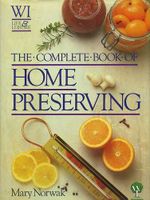Advertisement
Jam
By Mary Norwak
Published 1978
Wash and drain fruit and take out stems, leaves and bruised or damaged pieces. Stone fruit may be cooked whole and the stones removed during cooking, or the stones may be removed beforehand. Apricot, cherry, plum and greengage jams can be flavoured with a few kernels from their stones. The fruit should be cooked slowly in water until completely tender, adding acid during this cooking if specified. When the fruit is soft and the contents of the pan reduced by about one half, the sugar should be stirred in over low heat until dissolved. After that, the jam must be boiled rapidly to setting point, and should be tested after 5 minutes. Some jams take longer, but no jam needs to boil longer than 20 minutes. After testing for setting, skim the jam and leave it to cool for a minute or two, before stirring so that fruit does not rise in the jars. Pour into hot clean jars, filling right to the brim, and put on waxed discs at once, pressing carefully to exclude air bubbles. Put on top covers and clean the jars before labelling and storing in a cool dry place.

